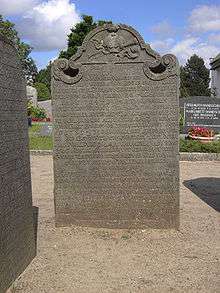Hark Olufs
| Hark Olufs | |
|---|---|
 Hark Olufs' tombstone in the cemetery of Nebel | |
| Born |
17 or 19 July 1708 Nebel, Amrum, Denmark. Now part of Germany. |
| Died |
October 13, 1754 (aged 46) Süddorf, Amrum |
| Resting place |
Nebel 54°39′11″N 8°21′21″E / 54.6530°N 8.3558°E |
| Citizenship | Danish |
| Occupation | Sailor, treasurer, military commander |
| Known for | Returning from Algerian slavery as a wealthy man |
| Notable work | Autobiography |
|
Military career | |
| Allegiance |
|
| Service/branch | Life guards, later cavalry |
| Years of service | ca. 1728–1735 |
| Rank | Agha ed-Deira (Commander in Chief) |
| Battles/wars | Conquest of Tunis (1735) |
Hark Olufs (July 17 or 19, 1708, Nebel – October 13, 1754) was a North Frisian sailor. He was captured by Algerian pirates and sold into slavery but by successfully serving the Bey of Constantine he could eventually achieve his release.
Life
Hark Olufs was born as son of a nautical captain named Oluf Jensen on either July 17 or 19 in 1708 on the North Frisian island of Amrum, which then belonged to Denmark. In 1721 he became a seaman on the Hoffnung, one of his father's vessels.
In 1724, on a voyage from Nantes to Hamburg, his ship was seized by Algerian pirates, he and his two cousins were taken hostages. Olufs' family could not afford the high sum which was demanded by the slave traders for his release. Also, as the ship had been sailing under Hamburg colours, the family's request for a loan from the slavery fund of the Danish Kingdom was rejected.
Subsequently, Olufs was sold as a slave on Algiers' slave market. From 1724 to 1727/28 he was a servant of the Bey of Constantine, Algeria and advanced to become the Bey's treasurer. Between 1728 and 1732 he was made Commander of the Life Guards.
In 1732 he became Agha ed-Deira, Commander in Chief of the local cavalry. He took part in the conquest of Tunis by the Algerian army in 1735 and as a reward he was released on October 31, 1735, and was allowed to return to Amrum. In 1747 he published an autobiography in Danish language, which was translated to German in 1751. Hark Olufs died on October 13, 1754, in Süddorf on Amrum. His headstone is still visible in the graveyard of Nebel.
Legacy
Hark Oluf's life has been treated in a biographical novel in 2010:
- Weinbörner, Udo (2010). Der General des Bay. Das abenteuerliche Leben des Amrumer Schiffsjungen Hark Olufs (in German). Bad Honnef: Horlemann. ISBN 978-3-89502-299-9.
References
- "Ein Amrumer Schicksal im 18. Jahrhundert". Die Geschichte Norddeutschlands - Im Zeichen des Kreuzes (in German). March 13, 2007. Norddeutscher Rundfunk. Archived from the original on March 17, 2008. Retrieved November 24, 2014.
- Olufs, Hark. "Harck Olufs,... Besynderlige AVANTURES,... (Autobiography)" (in Danish). Martin Rheinheimer. Retrieved July 23, 2008.
- Rheinheimer, Martin (2007). Der fremde Sohn. Hark Olufs’ Wiederkehr aus der Sklaverei. (The alien Son. Hark Olufs' Return from Slavery.) (in German) (3rd ed.). Wachholtz. ISBN 978-3-529-02775-8.
- Rheinheimer, Martin (2001). "Hark Olufs and the Barbary States". University of Southern Denmark. Retrieved July 23, 2008.